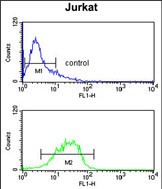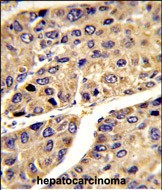


| WB | 咨询技术 | Human,Mouse,Rat |
| IF | 咨询技术 | Human,Mouse,Rat |
| IHC | 1/100-1/500 | Human,Mouse,Rat |
| ICC | 技术咨询 | Human,Mouse,Rat |
| FCM | 1/10-1/50 | Human,Mouse,Rat |
| Elisa | 咨询技术 | Human,Mouse,Rat |
| Aliases | Insulin-like growth factor-binding protein complex acid labile subunit, ALS, IGFALS, ALS |
| Entrez GeneID | 3483 |
| WB Predicted band size | 66.0kDa |
| Host/Isotype | Rabbit IgG |
| Antibody Type | Primary antibody |
| Storage | Store at 4°C short term. Aliquot and store at -20°C long term. Avoid freeze/thaw cycles. |
| Species Reactivity | Human, Mouse |
| Immunogen | This IGFALS antibody is generated from rabbits immunized with a KLH conjugated synthetic peptide between 308-335 amino acids from the Central region of human IGFALS. |
| Formulation | Purified antibody in PBS with 0.05% sodium azide,1%BSA and 50% glycerol.prepared by Saturated Ammonium Sulfate (SAS) . |
+ +
以下是3篇与IGFALS抗体相关的文献摘要概括:
---
1. **文献名称**: *"Clinical and Genetic Characterization of Patients with Acid-Labile Subunit (ALS) Deficiency"*
**作者**: Domené HM, et al. (2004)
**摘要**: 研究报道了因IGFALS基因突变导致的酸不稳定亚基(ALS)缺陷病例,通过特异性抗体检测发现患者血清中ALS蛋白完全缺失,伴随IGF-1和IGFBP-3水平显著降低,揭示了ALS在IGF系统调控中的作用。
---
2. **文献名称**: *"Development of a Novel ELISA for Human Acid-Labile Subunit (ALS) Measurement Using Monoclonal Antibodies"*
**作者**: Fukuoka H, et al. (2015)
**摘要**: 研究团队开发了一种基于单克隆抗体的高灵敏度ELISA方法,特异性检测人血清中的ALS蛋白。该方法成功应用于健康人群和生长激素缺乏症患者的ALS水平分析,证实了其在临床诊断中的潜力。
---
3. **文献名称**: *"A Case of Severe Short Stature Associated with Neutralizing Antibodies Against IGFALS"*
**作者**: Kumar A, et al. (2019)
**摘要**: 报道一例罕见病例,患者体内存在针对IGFALS的自身抗体,导致功能性ALS蛋白被中和,引发严重的生长迟缓和低IGF-1血症,首次提出自身免疫性ALS缺陷可能是儿童矮小症的新机制。
---
4. **文献名称**: *"Structural and Functional Analysis of IGFALS Mutations in Human Diseases"*
**作者**: van Duyvenvoorde HA, et al. (2010)
**摘要**: 通过晶体结构和抗体结合实验,分析了IGFALS基因突变对ALS蛋白三维构象的影响,发现部分突变导致抗体结合表位破坏,进而影响IGF-1/IGFBP-3复合物稳定性,为遗传性生长障碍提供了分子机制解释。
---
这些文献涵盖了IGFALS抗体在疾病诊断、检测方法开发及分子机制研究中的应用。
Insulin-like growth factor-binding protein acid labile subunit (IGFALS) is a critical component of the insulin-like growth factor (IGF) system, which regulates growth, metabolism, and cellular differentiation. Produced primarily in the liver, IGFALS binds to IGF-binding protein-3 (IGFBP-3) or IGFBP-5 and IGF-1/IGF-2 to form ternary complexes, stabilizing IGFs in circulation and extending their half-life. These complexes limit IGF bioavailability, modulating their interaction with cell surface receptors.
IGFALS antibodies are tools used to study IGFALS expression, complex formation, and its role in IGF regulation. Dysregulation of IGFALS is linked to growth disorders (e.g., short stature), metabolic syndromes, and certain cancers. For instance, IGFALS mutations cause acid labile subunit deficiency, characterized by low IGF-1 and growth hormone resistance. Antibodies against IGFALS enable detection in immunoassays (ELISA, Western blot) or tissue staining (IHC), aiding research into IGF pathway mechanisms and disease associations.
Commercial IGFALS antibodies are also employed in clinical diagnostics to assess IGF system abnormalities. Challenges include ensuring specificity due to structural similarities within the IGF family. Ongoing research focuses on IGFALS' therapeutic potential, particularly in metabolic and growth-related pathologies.
×